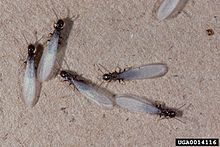| Reticulitermes virginicus | |
|---|---|

| |
| Scientific classification | |
| Domain: | Eukaryota |
| Kingdom: | Animalia |
| Phylum: | Arthropoda |
| Class: | Insecta |
| Order: | Blattodea |
| Infraorder: | Isoptera |
| Family: | Rhinotermitidae |
| Genus: | Reticulitermes |
| Species: | R. virginicus
|
| Binomial name | |
| Reticulitermes virginicus (Banks, 1907)
| |
Reticulitermes virginicus is a species of subterranean termite native to North America, found often in the southern United States.[1][2][3] It was described in 1907.[1]
Like all other termite species, R. virginicus is a eusocial species, characterized by individuals in a colony with overlapped generations cooperating in brood care and having reproductive division of labor.[4] The adults that grow wings and fly from the nest to find a mate and start a new colony are called alates, or winged reproductives. In this species they are dark brown. Alates leave the nest between early February and late May. They prefer warm and sunny afternoons after rain.[3] Like in all other termite species, all four of their wings are equal length.[5][6] R. virginicus alates have wings about 0.3 inches (0.76 cm) long with two visible, hardened and thickened veins.[3]
- ^ a b "ITIS Standard Report Page: Reticulitermes virginicus". www.itis.gov. Retrieved 2019-07-09.
- ^ "Reticulitermes virginicus (Banks, 1907)". www.gbif.org. Retrieved 2019-07-09.
- ^ a b c Su, Nan-Yao. "Native Subterranean Termites: Reticulitermes flavipes (Kollar), Reticulitermes virginicus (Banks), Reticulitermes hageni Banks (Insecta: Isoptera: Rhinotermitidae)." IFAS Extension, University of Florida.
- ^ Nowak, Martin A.; Tarnita, Corina E.; Wilson, Edward O. (August 2010). "The evolution of eusociality". Nature. 466 (7310): 1057–1062. Bibcode:2010Natur.466.1057N. doi:10.1038/nature09205. ISSN 0028-0836. PMC 3279739. PMID 20740005.
- ^ "Isoptera - Wiktionary". en.wiktionary.org. Retrieved 2019-07-09.
- ^ "ENT 425 | General Entomology | Resource Library | Compendium [isoptera]". projects.ncsu.edu. Retrieved 2019-07-09.